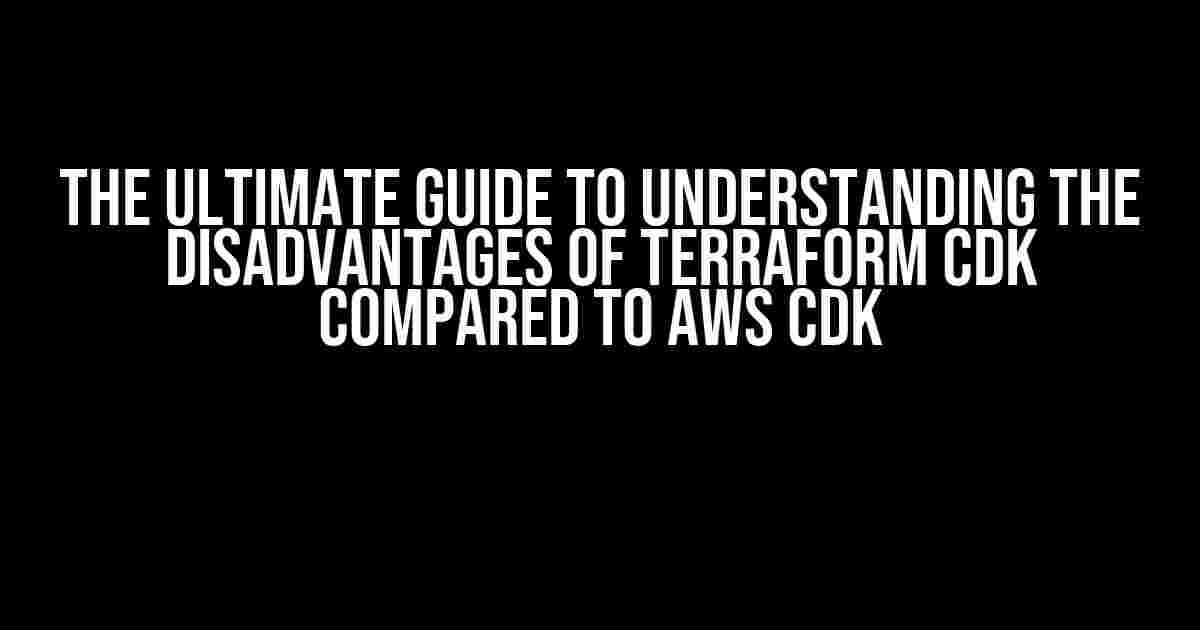Infrastructure as Code (IaC) is a crucial aspect of modern software development, and two popular tools for achieving this are Terraform CDK and AWS CDK. While both tools share some similarities, they also have some significant differences. In this article, we’ll delve into the disadvantages of Terraform CDK compared to AWS CDK, helping you make an informed decision for your next project.
What is Terraform CDK?
Terraform CDK is an open-source framework developed by HashiCorp, allowing users to define cloud and on-premises infrastructure in code. It provides a set of pre-defined resources and components that can be used to build, manage, and maintain infrastructure across multiple cloud providers, including AWS, Azure, and Google Cloud.
What is AWS CDK?
AWS CDK, on the other hand, is an open-source framework developed by AWS, specifically designed for defining cloud infrastructure in code. It provides a set of pre-defined resources and components that can be used to build, manage, and maintain infrastructure on the AWS cloud.
Disadvantages of Terraform CDK compared to AWS CDK
While Terraform CDK is a powerful tool, it has some disadvantages compared to AWS CDK, especially when it comes to AWS-specific use cases. Here are some of the key disadvantages to consider:
1. Learning Curve
Terraform CDK has a steeper learning curve compared to AWS CDK, especially for developers already familiar with AWS services. Terraform CDK requires a deeper understanding of the underlying infrastructure and the various components that make up the architecture.
In contrast, AWS CDK is designed specifically for AWS, making it easier for developers to learn and adapt, especially if they’re already familiar with AWS services.
2. AWS Service Integration
AWS CDK provides seamless integration with AWS services, making it easier to use services like IAM, S3, and Lambda. This integration allows for more efficient and effective use of AWS resources.
Terraform CDK, on the other hand, provides a more generic approach to infrastructure deployment, which can lead to additional complexity when integrating with AWS services.
3. Resource Support
AWS CDK provides support for a wider range of AWS resources and services, including newer services like AWS AppSync and AWS Lake Formation.
Terraform CDK, while supporting a wide range of resources, may lag behind in terms of supporting newer AWS services.
4. Drift Detection
AWS CDK provides built-in drift detection, which automatically detects and corrects configuration drift between the desired state of the infrastructure and the actual state.
Terraform CDK, on the other hand, relies on third-party tools and custom scripts for drift detection, which can be more complex and error-prone.
5. Security and Compliance
AWS CDK provides built-in support for AWS security and compliance features, such as IAM roles and security groups, making it easier to ensure the security and compliance of your infrastructure.
Terraform CDK, while providing some security features, may require additional configuration and setup to achieve the same level of security and compliance.
6. Cost Estimation
AWS CDK provides built-in cost estimation, allowing you to estimate the costs of your infrastructure before deployment.
Terraform CDK relies on third-party tools and custom scripts for cost estimation, which can be more complex and error-prone.
7. Community Support
AWS CDK has a larger and more active community, with more resources available for learning and troubleshooting.
Terraform CDK, while having a dedicated community, may not have the same level of support and resources as AWS CDK.
When to Choose Terraform CDK
Despite the disadvantages, Terraform CDK is still a popular choice for many developers and organizations. Here are some scenarios where Terraform CDK may be a better fit:
Multi-Cloud Environments
If you’re working in a multi-cloud environment, Terraform CDK is a better choice, as it provides support for multiple cloud providers, including AWS, Azure, and Google Cloud.
On-Premises Infrastructure
If you’re working with on-premises infrastructure, Terraform CDK is a better choice, as it provides support for a wide range of infrastructure components, including VMware, OpenStack, and more.
Conclusion
In conclusion, while Terraform CDK is a powerful tool for defining infrastructure in code, it has some significant disadvantages compared to AWS CDK, especially when it comes to AWS-specific use cases. AWS CDK provides better integration with AWS services, wider support for AWS resources, and built-in features like drift detection and cost estimation.
However, Terraform CDK is still a viable choice for scenarios that require multi-cloud or on-premises infrastructure support. Ultimately, the choice between Terraform CDK and AWS CDK depends on your specific needs and requirements.
Final Thoughts
Infrastructure as Code is a crucial aspect of modern software development, and choosing the right tool for the job is essential. By understanding the disadvantages of Terraform CDK compared to AWS CDK, you can make an informed decision for your next project.
Remember, both Terraform CDK and AWS CDK are powerful tools, and the choice ultimately depends on your specific needs and requirements. Take the time to evaluate both options and choose the one that best fits your project’s needs.
code block:
import * as cdk from 'aws-cdk-lib';
import * as iam from 'aws-cdk-lib/aws-iam';
export class MyStack extends cdk.Stack {
constructor(scope: cdk.Construct, id: string, props?: cdk.StackProps) {
super(scope, id, props);
const role = new iam.Role(this, 'MyRole', {
assumedBy: new iam.ServicePrincipal('ec2.amazonaws.com'),
});
const instance = new ec2.Instance(this, 'MyInstance', {
instanceType: ec2.InstanceType.T2_MICRO,
machineImage: new ec2.MachineImage({
imageId: 'ami-abcd1234',
}),
role: role,
});
}
}
| Terraform CDK | AWS CDK |
|---|---|
| Multi-cloud support | AWS-specific |
| On-premises infrastructure support | Cloud-only |
| Generic approach to infrastructure deployment | AWS service-specific integration |
| Third-party tools for drift detection and cost estimation | Built-in drift detection and cost estimation |
| Smaller community | Larger and more active community |
- Choose Terraform CDK for multi-cloud environments
- Choose Terraform CDK for on-premises infrastructure
- Choose AWS CDK for AWS-specific use cases
- Evaluate both options based on your project’s needs
- Consider the learning curve and resource support
- Look at the community support and resources available
- Terraform CDK
- AWS CDK
- Infrastructure as Code
- AWS services
- Cloud providers
- On-premises infrastructure
- Multi-cloud environments
By following this guide, you’ll be well on your way to making an informed decision for your next project. Remember to evaluate both options based on your project’s needs and requirements, and choose the tool that best fits your project’s needs.
Frequently Asked Question
Get the inside scoop on the downsides of Terraform CDK compared to AWS CDK, and make an informed decision for your infrastructure management needs!
What are the limitations of Terraform CDK when it comes to AWS services integration?
One major drawback of Terraform CDK is its limited support for AWS services integration. Unlike AWS CDK, which is built specifically for AWS and provides seamless integration with various AWS services, Terraform CDK supports a broader range of cloud providers, including AWS, Azure, and Google Cloud Platform. While this may seem like a benefit, it also means that Terraform CDK’s AWS integration is not as robust or well-maintained as AWS CDK’s.
How does Terraform CDK’s state management compare to AWS CDK?
Terraform CDK’s state management can be cumbersome and error-prone, especially when dealing with large-scale infrastructure deployments. AWS CDK, on the other hand, provides a more robust and intuitive state management system that’s tightly integrated with AWS CloudFormation. This makes it easier to track changes, manage dependencies, and troubleshoot issues.
What are the implications of Terraform CDK’s HCL syntax on development and collaboration?
Terraform CDK’s use of HCL syntax can be a barrier to adoption for developers who are already familiar with AWS CDK’s TypeScript or JavaScript syntax. This can lead to steeper learning curves, slower development cycles, and increased collaboration challenges. In contrast, AWS CDK’s syntax is more familiar to many developers, making it easier to onboard new team members and work together on infrastructure projects.
How does Terraform CDK’s pricing model compare to AWS CDK?
Terraform CDK can be more cost-effective than AWS CDK, especially for small- to medium-sized projects or for teams that require support for multiple cloud providers. However, as infrastructure complexity grows, Terraform CDK’s pricing model can become less competitive. AWS CDK, on the other hand, is free to use, with no additional costs or hidden fees.
What are the implications of Terraform CDK’s community support compared to AWS CDK?
Terraform CDK’s community support is smaller and less mature compared to AWS CDK’s. This can result in slower bug fixes, fewer community-driven plugins and tools, and less extensive documentation. AWS CDK, being an AWS-native service, benefits from a massive community of developers, engineers, and AWS experts who contribute to its growth and development.



![Docker Cloud Agent – Using a Custom Image with the Launch Attached Method [Closed] Docker Cloud Agent – Using a Custom Image with the Launch Attached Method [Closed]](https://freyde.hkhazo.biz.id/wp-content/uploads/sites/699/2024/07/docker-cloud-agent-using-a-custom-image-with-the-launch-attached-method-closed-with-text-300x300.jpg)